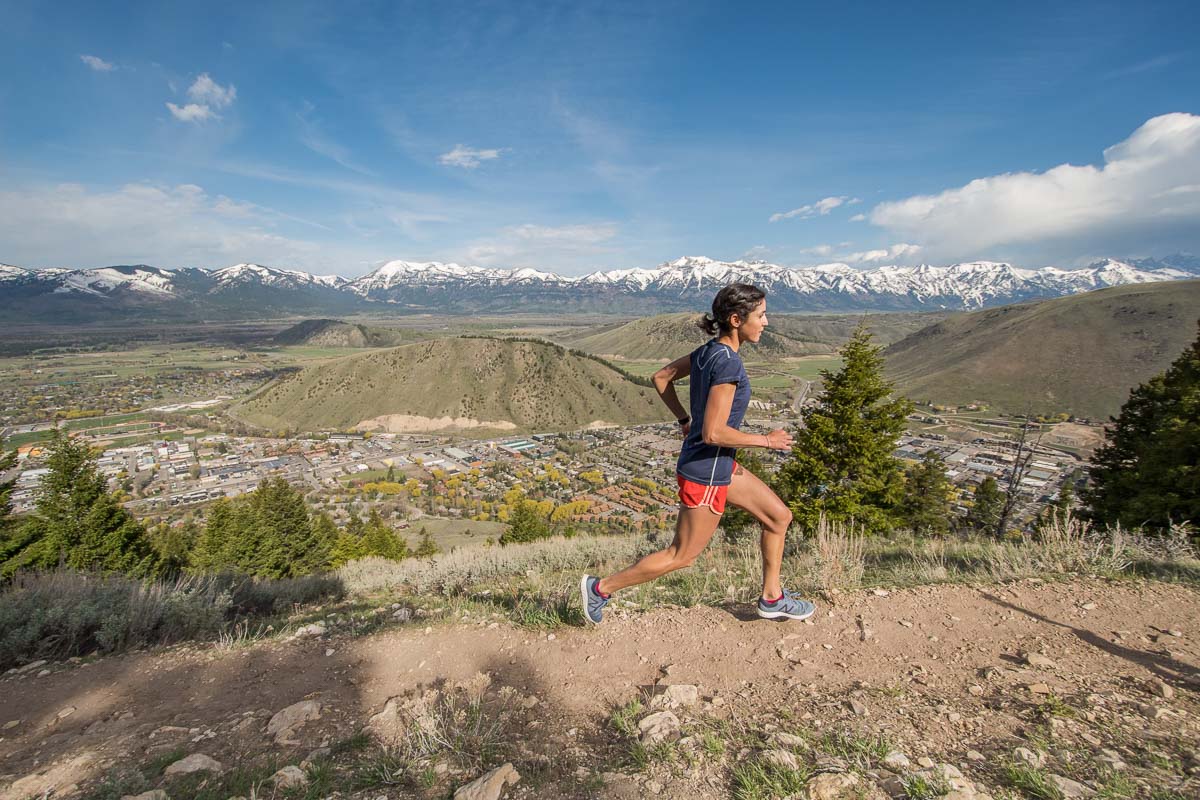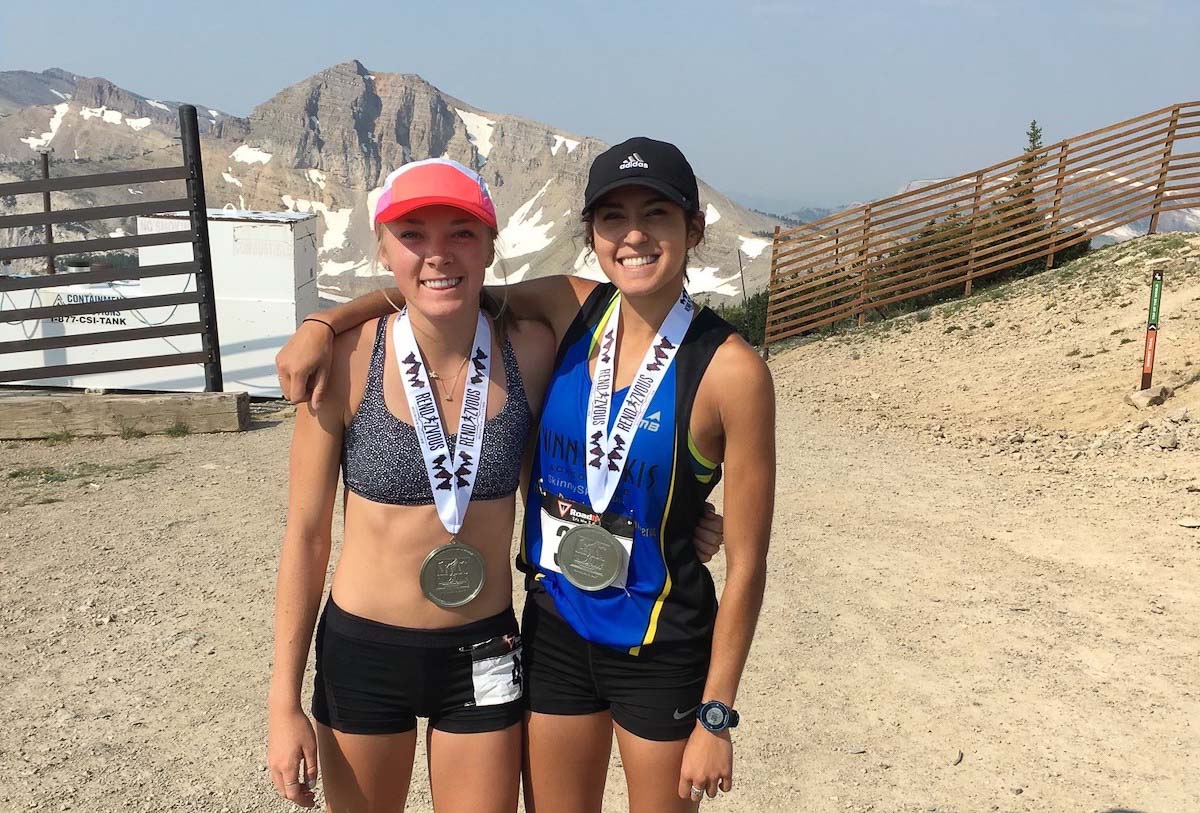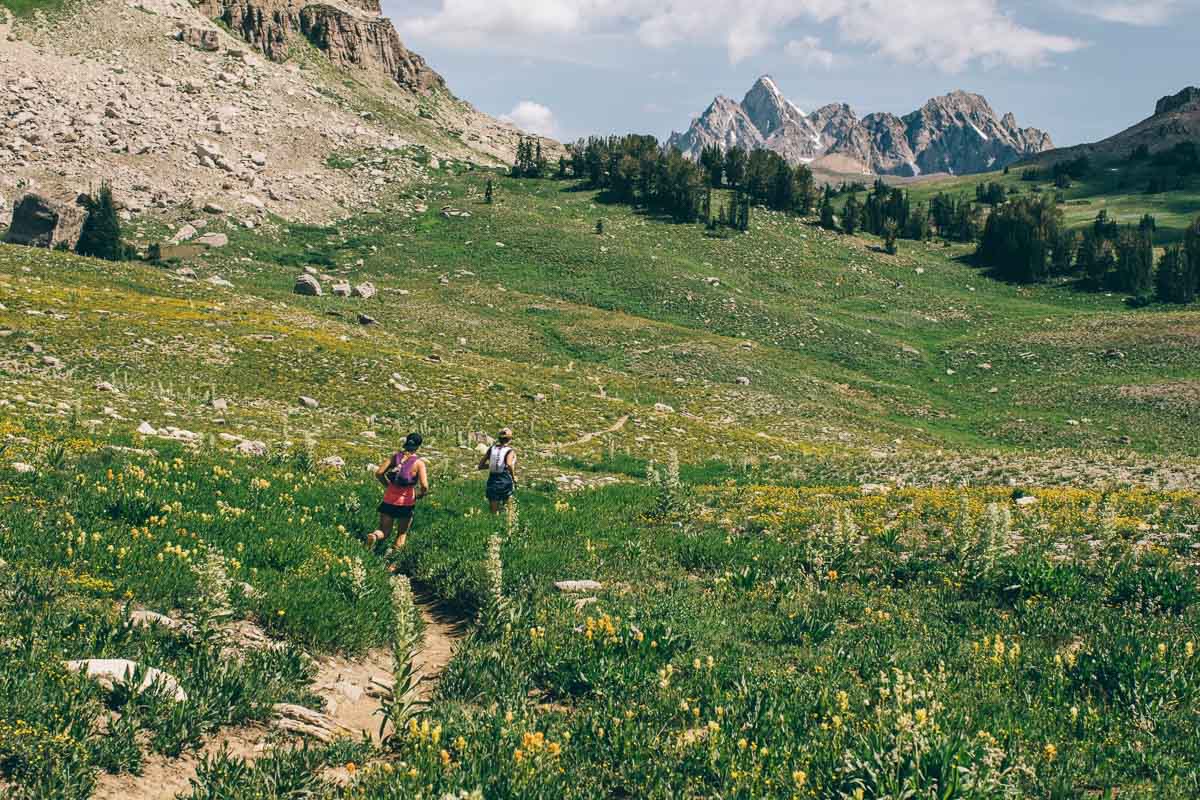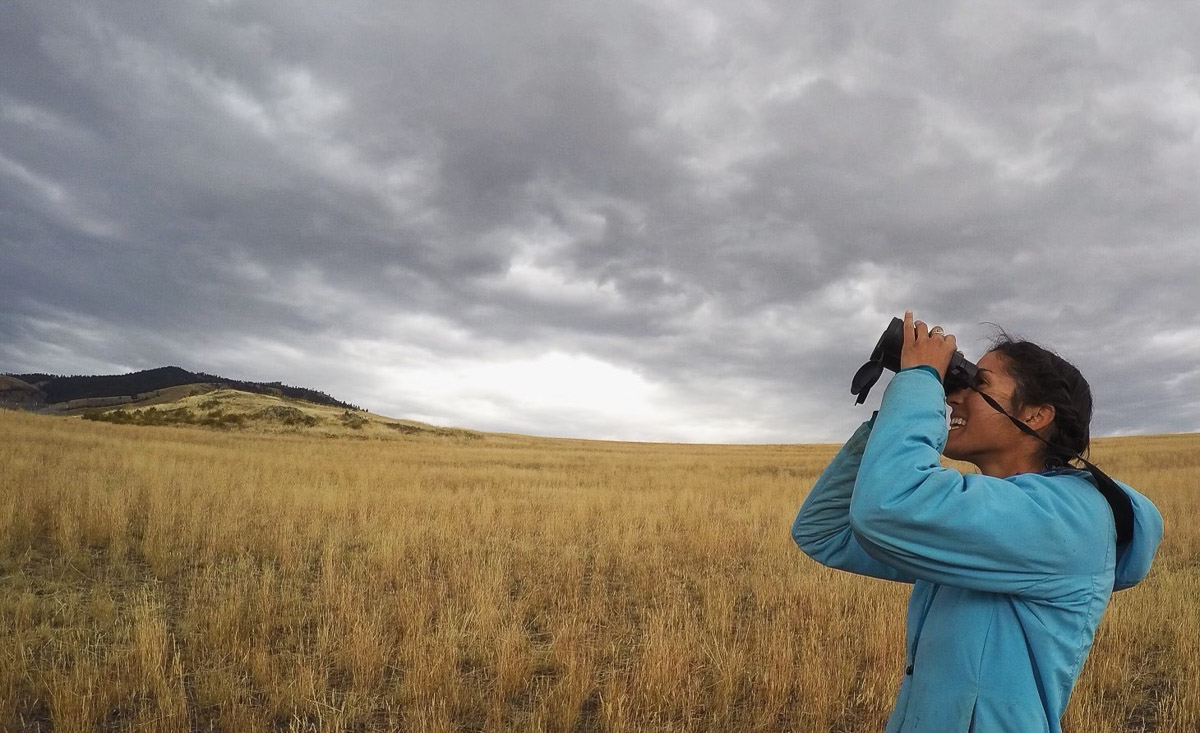Latinx trail runner and ultrarunner Sam Diaz speaks terrible Spanish, she admitted on our phone call. “Both of my parents’ families are from Mexico. My grandpa jumped a train and moved to Texas when he was young, then moved to California, where most of my family is,” said Diaz, who grew up in the Sacramento area.
Today, the collegiate runner, competitive athlete, and volunteer coach is an environmentalist and biologist based in Jackson, Wyoming, where she’s lived for nearly eight years. Diaz’s parents, recently retired, have since moved back south across the border.
“My mom grew up speaking beautiful Spanish, and my sister majored in it and has beautiful Spanish. I have go-to phrases, but it’s like rusty gears getting it in motion,” she said, smiling.

Sam Diaz running during her circumnavigation of the Tetons in Wyoming. All photos courtesy of Sam Diaz unless otherwise noted.
Finding a Love for Running
Her love for running began through intimidation. Diaz was in her fourth-grade physical-education class doing a baseline fitness test at the beginning of the school year.
“It’s the beep test. You stand in the gym and run from one end of the basketball court to the next, and you stay in as long as you can. The beeps get faster and faster. I ended up being one of the last kids,” she recalls. Her teacher told her to show up to cross-country practice after school, and the shy Diaz was too scared to say no but equally terrified of going to practice.
“It ended up being the absolute greatest thing that’s ever happened. We ended up having such a close-knit team. I didn’t realize how special it was until I got older. Four of us still do reunions with our coach every couple of years. Our coach, Barbara Richardson, remains a huge part of our lives, even now. She’s an absolute inspiration. I’m so glad she scared me into doing cross country,” Diaz said, who loved track during her years at Ponderosa High School.
She ran the 400-meter hurdles, 4 x 100-meter relay, and 800-meter run. She ran the 5k in cross country, placing third at the state meet in 2008, Diaz’s junior year. By her senior year, she qualified for the state meet in the extremely competitive 800-meter event.

Sam (right) with her cross-country team in high school.
Struggling Through College Racing
Diaz went on to run at the University of Nevada in Reno, not too far from where she grew up, just on the other side of Lake Tahoe. She studied Wildlife Ecology and Conservation, and had another amazing coach, but struggled with health issues, despite dialing in her fitness, during the fourth year of her five-year undergraduate program.
“I gained 20 pounds within a month. It was so bizarre, and really threw my body for a loop. It might have been cortisol levels, a thyroid issue, or burnout,” she said.
“That was mentally really hard. I’d never had an issue with food, but I would stress and even stress-eat about the sudden change,” she recalled, and then added, “My coach told me, ‘You’re so passionate and you care so much, I think you put yourself in this stress ball spiral,’ which made my health even worse.”
After two years of working with her coach, she mentally trained herself to control what factors she could and allow all the other variables to roll away.
“I had to learn, all I can do is to train and go day by day. It took a couple of years of focusing on the smaller picture and doing what I knew how to do. It made college racing hard. I’m so grateful for my coach and assistant coach,” Diaz said.
For her closing collegiate track meet, her coach encouraged her to try something completely new so she would have fun: the 10k instead of the 1,500-meter run.
“My coach said, ‘You know your body is not where you want it to be. With that mindset, you won’t be able to perform what you want to perform in the 1,500. Rather than have you go into your last conference meet tearing yourself apart, let’s throw you in something different — the 10k.
“Go out on cruise control, whatever feels good for the first four miles, then at mile five, you can just let loose. I want you to just go and run a 1,500 in the 10k.’ It was so much fun, because I had never run a 10k before, and had nothing to compare it to. It’d be a PR [no matter what],” she said.
Ski Bumming and Trail Running
After college graduation, Diaz moved with four friends to Jackson, Wyoming, to live the ski bum life — and never left. After taking a couple of years off of running, she got an itch.
“There are these fun, local races that got me back into running and back into having fun. I love training, and racing is equally as fun, if not more,” says Diaz, who signed up for the 2015 Rendezvous Mountain Hillclimb, a “Type Two Fun” event every August, with only a month to train. She ended up winning.

Anna Gibson (left) and Sam after the Rendezvous Mountain Hillclimb in Wyoming.
“I had a blast. I was like, I guess I like running uphill too. I mountain biked a lot that summer, and to this day think mountain biking for uphill races is almost equally as good as running every day. My lungs were so strong, and I was happily clueless about how challenging it would be to run at high altitude,” she remembered.
The experience relit her fire for running, and she signed up for more local races including the annual Run and Ride for the Cure. She also ran the annual Old Bill’s Fun Run, a huge annual community fundraiser: the event raised nearly $20 million in support of local nonprofits in 2021, a 29% increase over the previous year. In 2020, she and friend Anna Gibson ran the Teton Crest Trail unsupported, achieving the then women’s unsupported fastest known time (FKT) — which has since been beaten, but only by just over one minute — in 8:45:05.
Gibson and Diaz had run together in high school. “We said, ‘Let’s have fun.’ She knew I wanted the FKT. I let her lead. We had a blast, and on that last climb — which is the most soul-sucking dark place — going up Paintbrush Divide, she was my orb of light. She had never run more than 15 miles in her life,” said Diaz, who wasn’t much different.
She’d always focused on shorter distances, and when a friend first invited her to run the Teton Crest Trail, she was training for a marathon, so the sound of 44 miles terrified her.

Sam and Anna running the Teton Crest Trail in the Teton Range of Wyoming. Photo: Andy Cochrane
“I did not bring enough food and water on the attempt — Anna saved me. She had a lot of those squeeze apple sauce packets. I had dry peanut butter and jelly sandwiches and Clif Bars and didn’t want to chew anything,” said Diaz.
Paying forward her hard-earned cross-country knowledge, Diaz also became a volunteer assistant coach for the local high-school cross-country team. “The girls are insanely good. The run community here is good and small. It was nice to start running with the girls at practice — they whipped me into shape quickly — and they are such good kids and so fun to be around,” described Diaz.
Raptors and Owls and Puppies, Oh My!
For work, Diaz took on a role at the Teton Raptor Center, an organization dedicated to the rehabilitation, conservation, and education of birds of prey. For several years, she worked in the conservation department, helping with field research including a project focused on tracking the golden eagle migration path, which is full of windy ridges that are also an excellent corridor for wind farms — but that development is harmful to golden eagles.
“Birds of prey aren’t used to looking for wind farms, and they can get whacked. That data helps to inform infrastructure and prevent wind farms from going up into their migration corridor,” said Diaz.
Diaz also hiked around the mountains to find the nesting sites and track the migration of great gray owls. “Great grays go back to the same nest each year, so you spend the day hiking around their habitat, make bird calls, and hope they call back. We follow their species through the winter too, to track them during high snowpack levels and see what their food source is doing, and track their day to day,” explained Diaz, who learned how to listen for creatures from squirrels to gray jays, which imitate the noise of predators around them.

Sam scanning for hawks during their fall migration period.
One of the biggest wildlife trends she studied was in a group of birds coming through the rehab center. They all had high levels of lead in their blood from lead ammunition, left behind in gut piles after a hunt, picked up by birds of prey or scavengers feeding on the carcass.
“The Conservation Director [at the Raptor Center] Bryan Bedrosian started promoting lead-free ammunition for hunting, and he founded the organization Sporting Lead-Free, because a lot of people don’t think about it,” said Diaz.
“Lead is the most prevalent and cheapest bullet. When you shoot lead, it fragments. Small levels of lead in [animals’] tiny bodies is incredibly deadly. They [can’t] function. Lead poisoning makes them very vulnerable to other predators in the area too. But, [prevention has] been promoted really well around here, and is starting to catch on.”
Diaz still volunteers with the Teton Raptor Center but recently transitioned into a new role with a local nonprofit called Paws of Jackson Hole, which focuses on animal welfare. Recently, the organization acquired a shelter in Driggs, Idaho, across Teton Pass and northwest of Jackson.
“It’s an open submission shelter for the community if they need to do surrenders or find strays and it’s mostly cats and dogs,” said Diaz. Ann Smith, the founder, opened the shelter opened 25 years ago. Today, Paws offers community services such as its MedFund, a financial assistance program for veterinary emergencies — like if your dog eats a tennis ball and needs a $2,000 surgery.
“I started working there in September 2021, and it’s amazing. Our boss is so good. We work hard and get our work done, but if you want to run on your lunch break or come in an hour later in order to run or ski, that’s fine. She’s very understanding that we take time for ourselves, too, which is important,” said Diaz.

Sam (center) and other members of her team at night looking for flammulated owls. Photo: Andy Cochrane
On the Trail and the Road
As an environmentalist and biologist, Diaz says that the biggest way trail runners and outdoor enthusiasts can make a difference in their own backyard is to follow Leave No Trace Principles from carrying out all your trash, to knowing where to go to the bathroom if you’re not near a restroom, and treading lightly.
“Balloons are my number one pet peeve. I can’t tell you how many balloons I found doing fieldwork, in the trees and on the ground,” she said.
Ultimately, Diaz said, “Trail running is such a good way to get people outside. The more people you can get to trail run or to be outside, the more people you can get to protect it. It’s important for people to see and appreciate what we have and want to make sure it stays that way.”
Diaz continues her running adventures on and off the trail: in 2020, she ran the Olympic Marathon Trials in Atlanta, Georgia, finishing 189th out of 390 women in a time of 2:48:29. For 2022, she plans to race the 2022 Pikes Peak Marathon, Speedgoat 28k, and Broken Arrow 26k. “They’re all so different, which is what I think will be really fun,” she said.
Call for Comments
- Have you met Sam Diaz out on the trail? Come say hello!
- Have you gone through periods of up and down with your running, as Sam has?

Sam and Kristen Morse running a ridge on Teton Pass.
